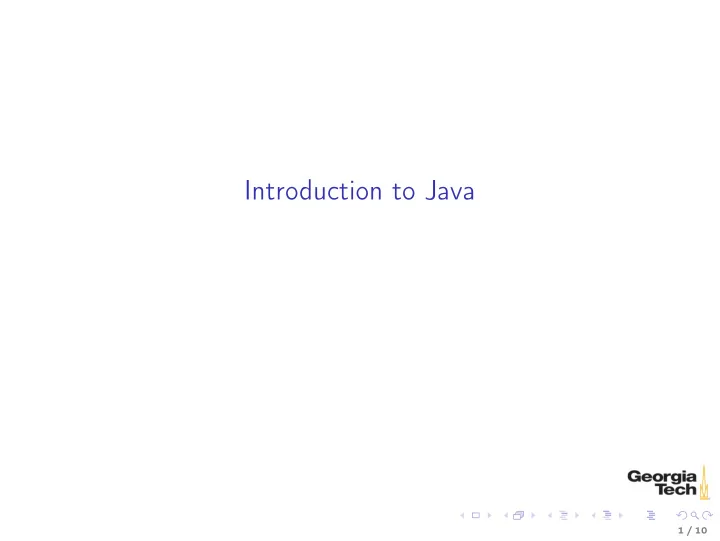

Introduction to Java 1 / 10
Java ◮ Developed for home appliances - cross-platform VM a key feature ◮ Originally called Oak ◮ Gained notariety with HotJava web browser that could run “programs over the internet” called applets ◮ Gained popularity when Netscape included Java VM in Navigator web browser ◮ JavaScript is purely a marketing label meant to capitalize on Java hype - there is no relationship between Java and JavaScript ◮ Java is a general-purpose application programming language. ◮ Java applets are now very rare. The bulk of Java code runs on (web) servers. 2 / 10
The Java Programming Language ◮ Java is part of the C family. Same syntax for variable declarations, control structures ◮ Java came at a time when C++ was king. C++ was a notoriously complex object-oriented extension to C. ◮ Java improved on several key aspects of C++, greatly simplifying software development ◮ Two most compelling features of Java were cross-platform deployablility (“write once, run anwhere”) and autoatic garbage collection ◮ These two advantages, especially garbage collection, drove Java adoption 3 / 10
The Java Platform Three components of the Java platform: ◮ The Java programming language ◮ The Java Virtual Machine (JVM) ◮ The Java standard library Java is both compiled and interpreted: ◮ Java source files (ending in .java ) are compiled to java bytecode files (ending in .class ) ◮ Java bytecode is then interpreted (run) by the JVM ◮ Compiling and running can be done on different machines – bytecode is portable (more precisely, the JVM on each platform accepts the same bytecode). The enourmous Java standard library (containing many Classes notably missing from C++) greatly reduces software development effort. 4 / 10
Object-Oriented Programming in Java Java is an imperative programming language (we’ll learn what that means next class) with support for object-oriented programming. ◮ All Java code resides within classes ◮ Classes define state (member variables) and behavior (methods) ◮ Objects are instantiated from ~class~es (we’ll see examples soon) ◮ An object-oriented program models some system as a collection of objects ◮ Each object communitcates with other objects by sending them messages, or invoking methods on those objects 5 / 10
The Java SDK Follow the instructions on the Resources page of the course web site to install the JDK. Installing the JDK on your computer provides you with several command-line tools, the most important of which are: ◮ javac - the Java compiler, which compiles .java files to .class files. You can tell you have correctly installed your SDK like this: $ javac -version javac 1.8.0_111 ◮ java - the Java runtime program, which runs compiled .class files. You can tell you have a correctly installed JRE (Java Runtime Environment) like this: $ java -version java version "1.8.0_111" Java(TM) SE Runtime Environment (build 1.8.0_111) Java HotSpot(TM) 64-Bit Server VM (build 25.11-b03, mixed mode) The JRE is included in the JDK, but they can be installed separately. 6 / 10
The Anatomy of a Java Program It is customary for a progarmmer’s first program in a new language to be “Hello, World.” Here’s our HelloWorld.java program: public class HelloWorld { public static void main(String[] args) { System.out.println("Hello, world!"); } } ◮ The first line declares our HelloWorld class. class is the syntax for declaring a class, and prepending with the public modifer means the class will be visible outside HelloWorld ’s package. For now just think of them as boilerplate. ◮ Because we didn’t declare a package explicitly, HelloWorld is in the default package. More on that in a few lectrues. ◮ The code between the curly braces, { ... } define the contents of the HelloWorld class, in this case a single method, main 7 / 10
public static void main(String[] args) In order to make a class executable with the java command, it must have a main method: public static void main(String[] args) { ... } ◮ The public modifier means we can call this method from outside the class. ◮ The static modifer means the method can be called without instantiating an object of the class. Static methods (and variables) are sometimes called class methods. ◮ void is the return type. In particular, main returns nothing. Sometimes such subprograms are called procedures and distinguished from functions , which return values. ◮ After the method name, main , comes the parameter list. main takes a single parameter of type String[] - an array of ~args is the name of the parameter, which we can String~s. refer to within the body of main 8 / 10
Compiling Java Programs Compile Java programs with javac , which stands for “Java compiler” $ javac HelloWorld.java With no command line options, javac will look in the present working directory ( pwd ) for any .java files you pass to javac and produce corresponding .class files. After compiling HelloWorld.java you should have a HelloWorld.class in the same directory. $ ls HelloWorld.class HelloWorld.java 9 / 10
Running Java Programs Run Java programs with java $ java HelloWorld Hello, world! ◮ The HelloWorld argument tells the java command to find the .class file named HelloWorld (which could be a file or in a JAR archive) and execute its main method. This is all you need to know for now. 10 / 10
Recommend
More recommend